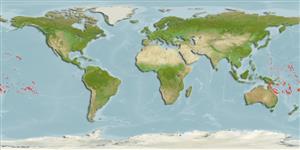Environment: milieu / climate zone / depth range / distribution range
Ecologie
marien rifbewoner; diepte 0 - 10 m (Ref. 89707), usually 0 - 3 m (Ref. 9710). Tropical; 30°N - 29°S, 139°E - 123°W (Ref. 5222)
Pacific Ocean: islands of Oceania; Ogasawara Islands, Marcus Islands, Mariana Islands, Marshall Islands, Phoenix Islands, American Samoa, Cook Islands, Line Islands, Society Islands, Rapa, Tuamoto Islands, and the Pitcairn Group. Unknown in Hawaii, the Marquesas, Caroline Islands, nor in any Melanesian islands.
Grootte / Gewicht / Leeftijd
Maturity: Lm ? range ? - ? cm
Max length : 52.0 cm TL mannelijk / geslacht onbekend; (Ref. 9710)
Dorsale stekels (totaal): 11; Dorsale zachte stralen (totaal): 14-16; Anale stekels 3; Anale zachte stralen: 8. Preopercle rounded, finely serrate; upper edge of the operculum sinuous; nostril subequal; maxilla reaches past vertical at rear edge of the eye. Pectoral fins fleshy. Head and body whitish, with small close-set blackish-brown spots, those on the rear part of the body coalesced to form irregular longitudinal bands. Four dark blotches usually at the base of the dorsal fin and a fifth forming a dark saddle blotch on the peduncle. Fins with small white spots and whitish margins, usually with a black submarginal band; body depth contained 2.9-3.4 times in SL; head length 2.4-2.6 times in SL (Ref. 89707).
This shallow-water species is more common on atolls than high islands, and usually found in exposed outer-reef areas. Not dependent on coral cover (Ref. 89707). Juveniles and occasionally adults are collected from tide pools. Feeds on crustaceans (mainly grapsid crabs), octopi, and fishes.
Levenscyclus en paargedrag
Maturiteit | Voortplanting | Paaien | Eieren | Fecunditeit | Larven
Heemstra, P.C. and J.E. Randall, 1993. FAO Species Catalogue. Vol. 16. Groupers of the world (family Serranidae, subfamily Epinephelinae). An annotated and illustrated catalogue of the grouper, rockcod, hind, coral grouper and lyretail species known to date. Rome: FAO. FAO Fish. Synop. 125(16):382 p. (Ref. 5222)
Status op de Rode Lijst van het IUCN (Ref. 130435)
Gevaar voor de mens
Harmless
Gebruik door de mens
Visserij: van minder commercieel belang
Meer informatie
Lokale namenSynoniemenMetabolismePredatorenEcotoxicologieVoortplantingMaturiteitPaaienPaaiaggregatiesFecunditeitEierenOntwikkeling van de eieren
ReferentiesAquacultuurAquacultuurprofielKweeklijnenGeneticaElectrophoresesErfelijkheidZiektesVerwerkingNutrientsMassaconversie
Tools
Speciale rapporten
Download XML
Internetbronnen
Estimates based on models
Preferred temperature (Ref.
123201): 25.4 - 29.4, mean 28.1 °C (based on 712 cells).
Fylogenetische diversiteitsindex (Ref.
82804): PD
50 = 0.5000 [Uniqueness, from 0.5 = low to 2.0 = high].
Bayesian length-weight: a=0.01175 (0.00571 - 0.02419), b=3.04 (2.88 - 3.20), in cm total length, based on LWR estimates for this Genus-body shape (Ref.
93245).
Trofisch niveau (Ref.
69278): 4.2 ±0.64 se; based on food items.
Weerstandsvermogen (Ref.
120179): Gemiddeld, minimale populatieverdubbelingstijd 1,4-4,4 jaar (Preliminary K or Fecundity.).
Fishing Vulnerability (Ref.
59153): Moderate vulnerability (41 of 100).
Nutrients (Ref.
124155): Calcium = 30.2 [14.4, 64.3] mg/100g; Iron = 0.471 [0.249, 1.005] mg/100g; Protein = 18.8 [17.2, 20.2] %; Omega3 = 0.107 [0.064, 0.176] g/100g; Selenium = 23.4 [13.0, 45.6] μg/100g; VitaminA = 206 [53, 793] μg/100g; Zinc = 1.28 [0.86, 1.85] mg/100g (wet weight);
